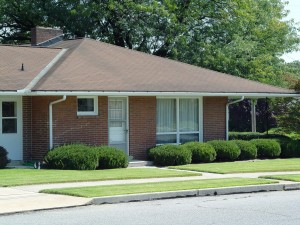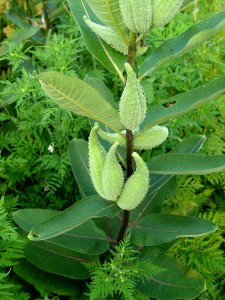Wildlife-Friendly Landscapes
April 23rd, 2009
Dr. Doug Tallamy is fighting an uphill battle – trying to convince people that bugs in their yard is actually a GOOD thing.
It’s a tough sell to gardeners and yardeners who have been trained for generations that anything that crawls on a plant is bad and should be sprayed immediately. Then everything else should be sprayed, too, “just in case.”
Tallamy, a University of Delaware entomology professor who’s attained ecological rock-star status with his book “Bringing Nature Home” (Timber Press, 2007, $27.95), says our typical yard-care practices are slowly destroying nature and, in some ways, ourselves as well.

"Sterile" front yards like this are not uncommon in many of our housing developments.
“We have sterilized most of our suburban neighborhoods to the point where nature is gone,” he says.
And it’s not just the spraying.
By cutting down forests to the tune of 2 million acres a year and replacing those rich habitats with roads, houses and big lawns (which Tallamy calls “ecological dead zones”), we’re endangering hundreds of bug species.
Why should we care?
Because like it or not, bugs are key players in the same ecosystem and food web that we depend on for life.
“Insects are the rivets that hold the ecosystem together,” says Tallamy.
Besides serving as “nature’s bird food,” insects and the plants and wildlife they connect with are responsible for critical needs we take for granted – things like purifying water, feeding the air with oxygen, creating topsoil, pollinating our food crops, even affecting the weather.
Few people make this connection, Tallamy says.
When it comes to our little corners of the Earth, most of us are mainly interested in a landscape that looks reasonably good and doesn’t cause us much work.
Bugs are seen as the enemy.
There are signs this might be changing.
Climate change and a general increase in environmental concern are fueling some rethinking – both in homeowners and in the landscaping/horticulture industry.
Tallamy has been no small part. He’s been attracting surprisingly receptive and diverse audiences in talks all around the country.
A program last week in Mechanicsburg – sponsored by the Appalachian Audubon Society and Mechanicsburg’s Parks and Recreation Department – attracted some 500 listeners.
Tallamy told the group that even small changes in each yard can add up to an important difference.
“The first thing is to get more plants into the landscape,” he says.
The place to start – that big lawn.
Tallamy contends that lawns are great for walking and playing, but most of us way over-use wildlife-unfriendly grass.
“The only time most people even walk on their lawn is when they’re mowing,” he says. “It’s just too hot, barren and boring.”
Lawns offer little in the way of food or shelter to wildlife – not even remotely close to a landscape filled with berry-producing shrubs, pollen-producing flowers and the damp, shady, bug-rich leaf litter under a grove of trees.
If homeowners could even cut their lawns in half, that would return 20 million U.S. acres to the food web – about the size of Indiana, Tallamy says.
“We can do a much better job sharing our areas with other living things,” he adds.
Exactly which plants we pick also makes a big difference.
For the past few decades, home gardeners have leaned heavily on non-native plants from Asia and Europe – primarily for their ornamental and low-maintenance traits.
That’s a problem for two main reasons, Tallamy argues.

Some people see this milkweed as a, well, weed, but it spells life or death to a monarch butterfly.
First, about 90 percent of insects are “specializers.” They’ve evolved with familiar plants and depend on one or two particular kinds of plants to survive, such as monarch butterflies and milkweed.
When we cut down or spray milkweed, there goes the monarch food supply.
Our yards offer little backup. We’ve filled them largely with the same few “alien” plants that native wildlife don’t recognize and can’t use – fare such as azaleas, yew bushes, Japanese pachysandra, burning bushes and seas of neatly trimmed turfgrass.
Second and worse, some plants originally introduced as landscape plants have escaped into the wild, where they’re now growing unchecked and choking out the native plants that our native wildlife need.
These include some of our worst invaders, such as Japanese honeysuckle, multiflora rose, the tree of Heaven, Oriental bittersweet and recently, some kinds of Japanese barberry and butterfly bush.
“About 85 percent of invasive woody plants are garden escapees that came from the horticultural industry,” Tallamy says.
He adds that, in general, native plants are the best lawn-replacers.
“All plants do not support wildlife equally,” he says. “But it’s not so simple as to just plant all natives because not all natives are equally supportive either.”
Examples: native oaks are capable of supporting 534 different kinds of caterpillars while native tulip poplars support only 21. Black cherries are useful to 456 caterpillar species while native redbuds attract 19 kinds.
Tallamy’s book goes into detail about the best wildlife-friendly landscape-plant choices. See the accompanying sidebar for some of them or visit online at http://bringingnaturehome.net/native-gardening.
Lorrie Preston, president of Appalachian Audubon Society, says gardeners need not rip out everything non-native and start from scratch. But any gradual switchovers or additions of natives in new areas would help.
“Every time you notice a plant in your yard that’s looking cruddy,” Preston says, “instead of spraying it again, dig it out and replace it with something that works a little better… We can all garden better for wildlife.”
Wildlife-Friendly Plant Species
If you’re trying to garden friendlier for native insects and wildlife, these are species recommended by Dr. Doug Tallamy, author of “Bringing Nature Home:”
Alder
American beech
American chestnut
Ash
Aster
Basswood
Beebalm
Birch
Blackberry/raspberry
Black-eyed susans
Black walnut
Blueberry
Cherry/plum
Coral honeysuckle
Crabapple
Elm
Evening primrose
Goldenrod
Hawthorn
Hazelnut
Hickory
Iris
Joe Pye weed
Little bluestem grass
Maple
Milkweed
Morning glory
Native geraniums
Native phlox
Native roses
Oak
Penstemon
Pine
Poplar
Sedge
Sunflower
Verbena
Veronica
Violets
Willow







